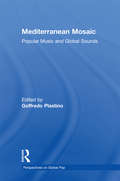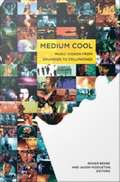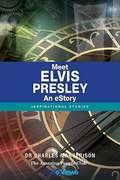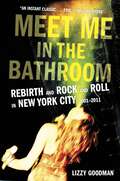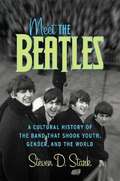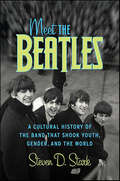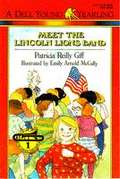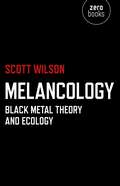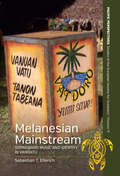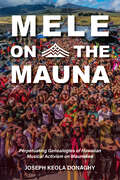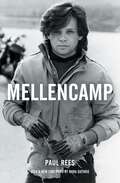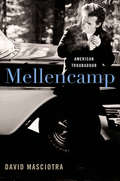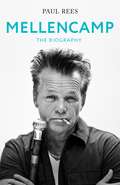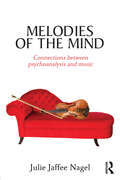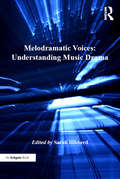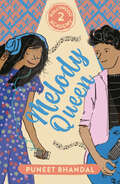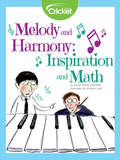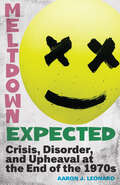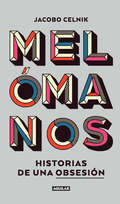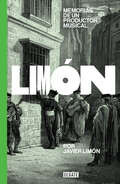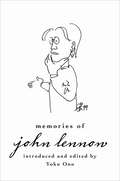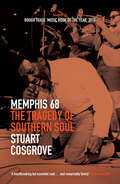- Table View
- List View
Mediterranean Mosaic: Popular Music and Global Sounds
by Goffredo PlastinoFirst published in 2003. Routledge is an imprint of Taylor & Francis, an informa company.
Medium Cool: Music Videos from Soundies to Cellphones
by Roger Beebe Jason MiddletonMusic videos are available on more channels, in more formats, and in more countries than ever before. While MTV--the network that introduced music video to most viewers--is moving away from music video programming, other media developments signal the longevity and dynamism of the form. Among these are the proliferation of niche-based cable and satellite channels, the globalization of music video production and programming, and the availability of videos not just on television but also via cell phones, DVDs, enhanced CDs, PDAs, and the Internet. In the context of this transformed media landscape, Medium Cool showcases a new generation of scholarship on music video. Scholars of film, media, and music revisit and revise existing research as they provide historically and theoretically expansive new perspectives on music video as a cultural form. The essays take on a range of topics, including questions of authenticity, the tension between high-art influences and mass-cultural appeal, the prehistory of music video, and the production and dissemination of music videos outside the United States. Among the thirteen essays are a consideration of how the rapper Jay-Z uses music video as the primary site for performing, solidifying, and discarding his various personas; an examination of the recent emergence of indigenous music video production in Papua New Guinea; and an analysis of the cultural issues being negotiated within Finland's developing music video industry. Contributors explore precursors to contemporary music videos, including 1950s music television programs such as American Bandstand, Elvis's internationally broadcast 1973 Aloha from Hawaii concert, and different types of short musical films that could be viewed in "musical jukeboxes" of the 1940s and 1960s. Whether theorizing music video in connection to postmodernism or rethinking the relation between sound and the visual image, the essays in Medium Cool reveal music video as rich terrain for further scholarly investigation. Contributors. Roger Beebe, Norma Coates, Kay Dickinson, Cynthia Fuchs, Philip Hayward, Amy Herzog, Antti-Ville Krj, Melissa McCartney, Jason Middleton, Lisa Parks, Kip Pegley, Maureen Turim, Carol Vernallis, Warren Zanes
Meet Elvis Presley - An eStory
by Charles MargerisonMeet Elvis Presley, a cultural icon all over the world and one of the most famous singers of the 20th century. You may know and love many of his songs and movies, but how much do you know about his real life? In this unique audio story from The Amazing People Club, gain new insight on the real life of the "The King" and follow him from the two-room shotgun house in Tupelo where he was born to the time he first walked into Sun Records in Memphis, which changed his life. Gain a fascinating insight on Elvis' life and better understand the man behind the legend through BioViews®.A BioView® is a short biographical story, similar to an interview. These unique audio stories provide an easy way of learning about amazing people who made major contributions to our world.
Meet Me in the Bathroom: Rebirth and Rock and Roll in New York City 2001-2011
by Lizzy GoodmanJoining the ranks of the classics Please Kill Me, Our Band Could Be Your Life, and Can’t Stop Won’t Stop, an intriguing oral history of the post-9/11 decline of the old-guard music industry and rebirth of the New York rock scene, led by a group of iconoclastic rock bands.In the second half of the twentieth-century New York was the source of new sounds, including the Greenwich Village folk scene, punk and new wave, and hip-hop. But as the end of the millennium neared, cutting-edge bands began emerging from Seattle, Austin, and London, pushing New York further from the epicenter. The behemoth music industry, too, found itself in free fall, under siege from technology. Then 9/11/2001 plunged the country into a state of uncertainty and war—and a dozen New York City bands that had been honing their sound and style in relative obscurity suddenly became symbols of glamour for a young, web-savvy, forward-looking generation in need of an anthem.Meet Me in the Bathroom charts the transformation of the New York music scene in the first decade of the 2000s, the bands behind it—including The Strokes, The Yeah Yeah Yeahs, LCD Soundsystem, Interpol, and Vampire Weekend—and the cultural forces that shaped it, from the Internet to a booming real estate market that forced artists out of the Lower East Side to Williamsburg. Drawing on 200 original interviews with James Murphy, Julian Casablancas, Karen O, Ezra Koenig, and many others musicians, artists, journalists, bloggers, photographers, managers, music executives, groupies, models, movie stars, and DJs who lived through this explosive time, journalist Lizzy Goodman offers a fascinating portrait of a time and a place that gave birth to a new era in modern rock-and-roll.
Meet the Beatles: A Cultural History of the Band That Shook Youth, Gender, and the World
by Steven D. StarkA discussion of the trends that created and followed the Beatles, tales of each members childhood,how their style represents mild gender bending, and attempts to describe their many long term impacts.
Meet the Beatles: A Cultural History of the Band that Shook Youth, Gender, and the World
by Steven D. StarkRob Sheffield, the Rolling Stone columnist and bestselling author of Love Is a Mix Tape, offers an entertaining, unconventional look at the most popular band in history, the Beatles, exploring what they mean today and why they still matter so intensely to a generation that has never known a world without them.Meet the Beatles is not another biography of the Beatles, or a song-by-song analysis of the best of John and Paul. It isn’t another exposé about how they broke up. It isn’t a history of their gigs or their gear. It is a collection of essays telling the story of what this ubiquitous band means to a generation who grew up with the Beatles music on their parents’ stereos and their faces on T-shirts. What do the Beatles mean today? Why are they more famous and beloved now than ever? And why do they still matter so much to us, nearly fifty years after they broke up?As he did in his previous books, Love is a Mix Tape, Talking to Girls About Duran Duran, and Turn Around Bright Eyes, Sheffield focuses on the emotional connections we make to music. This time, he focuses on the biggest pop culture phenomenon of all time—The Beatles. In his singular voice, he explores what the Beatles mean today, to fans who have learned to love them on their own terms and not just for the sake of nostalgia. Meet the Beatles tells the story of how four lads from Liverpool became the world’s biggest pop group, then broke up—but then somehow just kept getting bigger. At this point, their music doesn’t belong to the past—it belongs to right now. This book is a celebration of that music, showing why the Beatles remain the world’s favorite thing—and how they invented the future we’re all living in today.
Meet the Lincoln Lions Band
by Patricia Reilly GiffPa-dum. Pa-dum. Pa-dum. There's going to be a marching band at the Lincoln School! Drums...fifes...new uniforms...parades! Chrissie Tripp is going to sign right up. She just knows she'll make a great band kid. She's so sure, she tells her new friend, Michelle, she's already in the band. But then, gonzo! The president of the school, who just happens to be Chrissie's big-mouth sister, Theresa, makes a horrible announcement about the Lincoln Lions Band. If Chrissie doesn't do something fast, she's going to look like a liar--a big liar. Chrissie's new school year is off to a bad start. She cuts through the neighbor's yard, she sneaks in to school when she's not allowed, the teacher makes her sit in the trouble-maker's seat, she draws an ugly picture of her teacher, makes up nasty names for the new kids, lies about being in the band, breaks her sister's birthday present, gets in a big fight, and does more things she shouldn't. What she really wants is to be in the band, to do something important and to make friends and be happy in school. You'll love reading about this girl who is like lots of kids you know.
Meet the Orchestra
by Ann HayesThis lyrical romp through the orchestra begins with animal musicians slowly gathering for the evening performance. Poetic descriptions suggest the sounds of the instruments, and lively watercolor illustrations capture the playful essence of each musician and musical instrument. "It’s a smashing introduction to classical music, and a must prior to a first visit to the symphony. ”--Publishers Weekly
Meet the Singer! (Step into Reading)
by Steve FoxeLEGO© City fans will love this new MEET THE…LEGO City Step into Reading leveled reader series, featuring exciting careers including an astronaut, a singer, a firefighter, and more!Children ages 4 to 8, will love reading about Madison and Billy as they interview singing sensation Poppy Starr in this Step 3 Step into Reading leveled reader!Step 3 readers feature engaging characters in easy-to-follow plots about popular topics. For children who are ready to read on their own.LEGO, the LEGO logo, the Brick and Knob configurations and the Minifigure are trademarks of the LEGO Group.
Melancology: Black Metal Theory and Ecology
by Scott WilsonMelancology addresses the notorious musical genre black metal as a negative form of environmental writing that &‘blackens&’ the cosmos. This book conjures a new word and concept that conjoins &‘black&’ and &‘ecology&’: melancology, a word in which can be heard the melancholy affect appropriate to the conjunction. Black metal resounds from the abyss and it is precisely only in relation to its sonic forces that the question of intervention in the environment arises in the articulation of melancology with ethics. That is, in deciding &‘which way out&’ we should take, in deciding with what surpluses to dwell, with what waste, what detritus or decay in a process of unbinding with sonic forces that traverse an earth choking in wealth and death. The book thus provides a provocative and challenging contribution both to popular and intellectual debates on ecology.
Melanesian Mainstream: Stringband Music and Identity in Vanuatu (Pacific Perspectives: Studies of the European Society for Oceanists #11)
by Sebastian T. EllerichCitizens of Vanuatu (ni-Vanuatu) perceive stringband music as a marker of national identity, an indicator of their cultural, stylistic, and musical heritage. Through extensive field and ethnographic research, Melanesian Mainstream offers a detailed historical record of the roots, context, evolution, and impact of stringband music. Beyond chronicling the genre’s history and cultural significance, this thorough monograph positions the genre’s musical hybridity, communal lyrics, and unique organizational structures as key factors in the anthropological understanding of ni-Vanuatu socio-cultural history.
Mele on the Mauna: Perpetuating Genealogies of Hawaiian Musical Activism on Maunakea (Activist Encounters in Folklore and Ethnomusicology)
by Joseph Keola DonaghyIn the summer of 2019, a group of kia'i, or protectors, made up of kānaka 'ōiwi (Native Hawaiians) and their allies came together to prevent the construction of the Thirty-Meter Telescope (TMT) on the dormant volcano Maunakea. In Mele on the Mauna, Joseph Keola Donaghy explores how music, and especially haku mele, or Hawaiian language composers, played a crucial role in this defense. Musicians flocked to the mauna (mountain) to perform for the kia'i and a worldwide audience via social media. Haku mele created new songs at unprecedented levels, releasing many commercially with proceeds benefiting organizations providing support services and supplies to the kia'i. This book features over 30 of the author's interviews with individuals who participated in musical activities connected with this movement, including kia'i and their supporters, composers, musicians, and community leaders. Donaghy explores Indigenous Hawaiian concepts and theories like mana (power), mo'okū'auhau and pilina (genealogy and relationships), kapu aloha (philosophical code of conduct), and aloha 'āina (love of land, patriotism), and western academic concepts like connectedness and community building, poetics, sound(ing) and silenc(e/ing), conflict, and creativity.Mele on the Mauna illuminates how music played a powerful role in building solidarity, inspiration, and activism, reveling in the most contentious confrontations about protecting Maunakea and the outpouring of musical performances and creativity that occurred.
Mellencamp
by Paul ReesThe definitive biography of John Mellencamp, the iconic American rock and roll original, featuring exclusive in-depth interviews and never-before-told details. Perfect for fans of Janis and Born to Run.John Mellencamp is not your typical rock star. With music inspired by the work of William Faulkner, John Steinbeck, and other giants of American literature, he has experienced a colorful career unlike any other. Now, this fascinating biography fully charts the life of one of this country&’s most important voices in American music. Mellencamp&’s story is also the story of the American heartland. His coming of age as an artist and evolution into legendary status directly reflected the major changes of the last fifty years. From the Summer of Love to the growing divisiveness of American politics and beyond, his music has served as the backdrop to this evolving country for millions of fans. Featuring exclusive interviews with friends, family, and colleagues, and exploring everything from the founding of Farm Aid to his induction into the Rock and Roll Hall of Fame, this is a fresh and expansive look at a true original.
Mellencamp: American Troubadour
by David MasciotraAn in-depth biography of &“a major artist whose work is sometimes obscured by the shadows of Bob Dylan and Bruce Springsteen&” (Craig Werner, author of Up Around the Bend: An Oral History of Creedence Clearwater Revival). Despite his numerous hits and Grammy nominations—and his induction into the Rock & Roll Hall of Fame—John Mellencamp remains one of America&’s most underrated songwriters. In Mellencamp, David Masciotra explores the life and career of this important talent, persuasively arguing that he deserves to be celebrated alongside artists like Bruce Springsteen, Neil Young, and Bob Dylan. Starting with his modest beginnings in Seymour, Indiana, Masciotra details Mellencamp&’s road to fame, examining his struggles with the music industry and his persistent dedication to his midwestern roots as he found success by remaining true to where he came from. From a cultural critic who has contributed to the Washington Post, Atlantic, and Los Angeles Review of Books and who &“writes with the precision and integrity and humanity of a great journalist&” (New York Times–bestselling author James Lee Burke), this thoughtful analysis highlights four decades of the artist&’s music, which has consistently elevated the dignity of everyday people and honored the quiet heroism of raising families and working hard.
Mellencamp: The Biography
by Paul ReesThe definitive biography of John Mellencamp featuring exclusive interviews and never-before-told details about the life of the iconic American rock and roll original.John Mellencamp is not your typical rock star.With music inspired by the work of William Faulkner, John Steinbeck, and other giants of American literature, Mellencamp is a complex, colorful and larger than life character who walks to the beat of his own drum. Or, as he told author and veteran music journalist, Paul Rees: 'I just refuse to take shit off anyone'. Now, this fascinating biography fully charts the life of one of this country's most important voices in American music.Mellencamp's story is also the story of the American heartland. His coming of age as an artist and evolution into legendary status directly reflected the major changes of the last fifty years. From the Summer of Love to the growing divisiveness of American politics and beyond, his music has served as the backdrop of this evolving country for millions of fans.For the first time, this story written with the cooperation and support of Mellencamp and his management will include extensive interviews with members of Mellencamp's family, many of his bandmates and collaborators, past and present, and Mellencamp himself. Together, they shed new light on a man hailed by none other than Johnny Cash as 'among our greatest living songwriters'. An exploration of everything from the founding of Farm Aid to his induction into the Rock and Roll Hall of Fame, this is a fresh and expansive look at a true original.
Melodies of the Mind: Connections between psychoanalysis and music
by Julie Jaffee NagelWhat can psychoanalysis learn from music? What can music learn from psychoanalysis? Can the analysis of music itself provide a primary source of psychological data? Drawing on Freud's concept of the oral road to the unconscious, Melodies of the Mind invites the reader to take a journey on an aural and oral road that explores both music and emotion, and their links to the unconscious. In this book, Julie Jaffee Nagel discusses how musical and psychoanalytic concepts inform each other, showing the ways that music itself provides an exceptional non-verbal pathway to emotion – a source of 'quasi' psychoanalytical clinical data. The interdisciplinary synthesis of music and psychoanalytic knowledge provides a schema for understanding the complexity of an individual's inner world as that world interacts with social 'reality'. There are three main areas explored: The Aural Road Moods and Melodies The Aural/Oral Road Less Travelled Melodies of the Mind is an exploration of the power of music to move us when words fall short. It suggests the value of using music and ideas of the mind to better understand and address psychological, social, and educational issues that are relevant in everyday life. It will be of interest to psychoanalysts, psychologists, music therapists, musicians, music teachers, music students, social workers, educators, professionals in the humanities and social services as well as music lovers. Julie Jaffee Nagel is a graduate of The Juilliard School, The University of Michigan, and The Michigan Psychoanalytic Institute. She is on the faculty of the Michigan Psychoanalytic Institute and is in private practice in Ann Arbor, Michigan.
Melodramatic Voices: Understanding Music Drama (Ashgate Interdisciplinary Studies in Opera)
by Sarah HibberdThe genre of mélodrame à grand spectacle that emerged in the boulevard theatres of Paris in the 1790s - and which was quickly exported abroad - expressed the moral struggle between good and evil through a drama of heightened emotions. Physical gesture, mise en scène and music were as important in communicating meaning and passion as spoken dialogue. The premise of this volume is the idea that the melodramatic aesthetic is central to our understanding of nineteenth-century music drama, broadly defined as spoken plays with music, operas and other hybrid genres that combine music with text and/or image. This relationship is examined closely, and its evolution in the twentieth century in selected operas, musicals and films is understood as an extension of this nineteenth-century aesthetic. The book therefore develops our understanding of opera in the context of melodrama's broader influence on musical culture during the nineteenth and twentieth centuries. This book will appeal to those interested in film studies, drama, theatre and modern languages as well as music and opera.
Melody Queen: Melody Queen (The Bollywood Academy #2)
by Puneet BhandalCan music-obsessed Simi stand up to a gender-biased industry? Twelve-year-old Simi's life is set. First: graduate from the Bollywood Academy, school to future stars. Second: become a super-famous actor, just like her showbiz parents. There's only one problem: Simi would rather make music than act, and music is a profession dominated by men. Can Simi navigate the gender barriers of the industry to prove she has what it takes to become Bollywood's next big music composer? A story of passion for music and courage in the face of overwhelming odds, this second book in the dazzling world of Bollywood is sure to get your toes tapping and head bopping to Simi's beat.
Melody and Harmony
by Diana Thistle Tremblay Annette CateDid you know that music is all about math? Every good composer knows their scales, along with the repetition, frequencies, and vibration that go into making harmonies and melodies that are pleasing to hear.
Meltdown Expected: Crisis, Disorder, and Upheaval at the end of the 1970s
by Aaron J. LeonardIn January 1978, President Jimmy Carter proclaimed that “There is all across our land a growing sense of peace and a sense of common purpose.” Yet in the ensuing months, a series of crises disturbed that fragile sense of peace, ultimately setting the stage for Reagan’s decisive victory in 1980 and ushering in the final phase of the Cold War. Meltdown Expected tells the story of the power shifts from late 1978 through 1979 whose repercussions are still being felt. Iran’s revolution led to a hostage crisis while neighbouring Afghanistan became the site of a proxy war between the USSR and the US, who supplied aid to Islamic mujahideen fighters that would later form the Taliban. Meanwhile, as tragedies like the Jonestown mass suicide and the assassination of Harvey Milk captured the nation’s attention, the government quietly reasserted and expanded the FBI’s intelligence powers. Drawing from recently declassified government documents and covering everything from Three Mile Island to the rise of punk rock, Aaron J. Leonard paints a vivid portrait of a tumultuous yet pivotal time in American history.
Melómanos: Retratos de una obsesión
by Jacobo CelnikDieciocho retratos de hombres y mujeres que encontraron en la música la razón de vivir. ¿Sobrevivirán a esta adicción? Pocas cosas despiertan en los seres humanos tantas pasiones y sentimientos encontrados como la música, pero mientras para la mayoría es sencillamente un pasatiempo, para otros se vuelve la razón de su existencia. Y dedican años a buscar y atesorar objetos y recuerdos que giran alrededor de su obsesión más preciada. En este libro, Jacobo Celnik, melómano incurable, pasea por la vida de un adicto a los Rolling Stones que sufre de insomnio porque su colección está incompleta; una esposa herida que toma medidas desesperadas para deshacerse de los discos de su futuro exmarido; un heroinómano que se consume su colección de rock; un enfermo terminal dedicado a llenar su apartamento de discos antes de morir; y una adicta al sonido en vivo, que a punta de ingenio y valentía, logra presenciar algunos de los eventos más importantes del rock sin pagar un centavo… Así, guiado por estanterías, pulgueros y sótanos, explora los aspectos emocionales y psicológicos del amor por la música, y retrata con nombre propio las historias de quienes cambiarían su reino por un disco, para sacudir esa incurable e inagotable obsesión que casi siempre termina en delirio.
Memorias de un productor musical
by Javier LimónUn maravilloso relato en primera persona de los últimos veinte añosen el mundo de la música en España. Javier Limón es probablemente el productor musical español más importante de los últimos veinte años. Ganador de ocho premios Grammy, ha producido casi cien discos de artistas como Diego el Cigala, Bebo Valdés, Paco de Lucía, Andrés Calamaro, Buika, Ana Belén, Antonio Orozco, Estopa, Joan Manuel Serrat y Joaquín Sabina, entre muchísimos otros. En estas fascinantes y divertidas memorias, repletas de anécdotas y de personajes conocidos, Limón nos cuenta como un chaval madrileño sin mucho talento musical se acabó convirtiendo en una leyenda de la música y en factor clave para el surgimiento de numerosos sonidos y movimientos en la escena musical española. Sobre el libro se ha dicho...«Disfrazado de profesional de la música, Javier Limón esconde en verdad a un profesional de la vida, alguien que ha hecho del disfrute un oficio».David Trueba «Javier Limón es un dínamo musical. En todo lo que hace se involucra con una energía y un entusiasmo que contagia. Tiene un amor por la música y por la vida, que unido a su experiencia y su talento sintético y minimalista, lo vuelven un compañero de trabajo creativo inigualable».Jorge Drexler «Me gustaría cantar para poder contar lo que Javier Limón aporta al arte y la cultura españoles; querría componer para poder compartir cómo Javier ha sabido hacerlo, con sus letras, sus notas, sus acordes, con su música; me encantaría saber recitar para trasladarle a todos los que se fijan, intuyen, escuchan, con la mente despejada, a corazón abierto, con los cinco sentidos, que sin Casalimón muchos artistas incipientes de enorme talento pero escasas oportunidades no habrían tenido ni tendrían un hogar... Javier, Eva... que ese aroma fresco que destiláis os acompañe, nos acompañe, siempre».Juan Cierco «Javi Limón no necesita el aplauso porque le sobra el talento. Es músico, productor y profesor. Atentos si abren estas páginas, este artista convierte la música en el mejor de los vicios».Mamen Mendizábal «Con Javier Limón aprendimos que en la radio, en la tele o allá dónde nos dejaran un hueco, todo por difícil que pueda parecer es posible, siempre y cuando encuentres a la persona capaz de transmitir su pasión, la música en el caso de Javier».Toni Garrido
Memories of John Lennon
by Yoko Ono“A wonderful book for fans of Lennon. . . . Highly recommended.” —Library JournalJohn Lennon . . . as much a part of our world today as he ever wasHe touched many lives in his brief forty years, and continues to move and inspire millions more to this day. Now, invited by Yoko Ono, friends, family, and fans from all walks of life—including some of the great artists of our day—reminisce about Lennon as a visionary and friend, musician and performer, husband and father, activist and jokester.In their own words and drawings, poems and photos, Lennon's life from his childhood through the Beatles years to the happiness and tragedy of his final days become stunningly vivid.Intimate glimpses gathered from musicians who knew John, such as Pete Townshend, Sir Elton John, Billy Preston, and Joan Baez; friends and relatives such as producer David Geffen, publicist Elliot Mintz, and cousin Mike Cadwallader; and artists who followed him such as Bono, Alicia Keys, Steve Earle, Jello Biafra, and Carlos Santana.And, for the first time, renowned photographer Annie Liebovitz presents every frame of the historic last session with John and Yoko.Memories of John Lennon is a rich and deeply felt appreciation of a truly great man.“Heartfelt . . . poignant reminders of why Lennon was so widely mourned and is missed to this day.” —Booklist
Memories: The Autobiography of Ralph Emery
by Tom Carter Ralph EmeryMemories is the autobiography of country music star Ralph Emery.
Memphis 68: The Tragedy of Southern Soul (The Soul Trilogy #2)
by Stuart CosgroveSecond in the award-winning soul music trilogy following Detroit 67—featuring Memphis artists Isaac Hayes, Mahalia Jackson, Otis Redding, and others. In the 1950s and 1960s, Memphis, Tennessee, was the launchpad for musical pioneers such as Aretha Franklin, Elvis Presley, Johnny Cash, Al Green, and Isaac Hayes, and by 1968, it was a city synonymous with soul music. It was a deeply segregated city, ill at ease with the modern world and yet to adjust to the era of civil rights and racial integration. Stax Records offered an escape from the turmoil of the real world for many soul and blues musicians, with much of the music created there becoming the soundtrack to the civil rights movement. The book opens with the death of the city&’s most famous recording artist, Otis Redding, who died in a plane crash in the final days of 1967, and then follows the fortunes of Redding&’s label, Stax/Volt Records, as its fortunes fall and rise again. But as the tense year unfolds, the city dominates world headlines for the worst of reasons: the assassination of civil rights leader Martin Luther King Jr. Winner of the Penderyn Music Book Prize in 2018 &“As ever, Cosgrove&’s lucid, entertaining prose is laden with detail, but never at the expense of the wider narrative. Hinging on that Memphis destination, he traces the savage dichotomy at the city&’s heart: it was the site of multi-racial soul imprint Stax, but also the place where Martin Luther King was killed. A heartbreaking but essential read, and one that feels remarkably timely.&” —Clash Magazine
